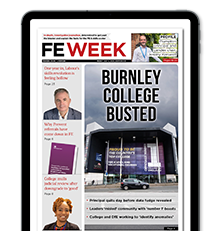My college had always planned to launch its digital development programme in September 2020, but the advent of the pandemic meant we had to go further, faster. As we responded to the need to deliver learning online for a prolonged period, I was in the privileged position of strategically leading this digital transformation with a team of specialists.
As I often am when I reflect on leadership, I was immediately taken back to a book I’d read in 2012 and which has shaped my thinking ever since: Will it make the boat go faster? by Olympic gold-medal winning rower, Ben Hunt-Davis and executive coach, Harriet Beveridge. I could only over-simplify the book’s ideas here, but its key questions never fail me when I’m entrusted to make change at any level, especially an institutional one.
My starting point for consideration was therefore to ask if my institution would benefit from a clear strategy and approach to the use of edtech. Would it improve teaching, learning and assessment and enhance provision? In the context of the pandemic, when it was that or nothing, the answer was a no-brainer, but the question forced me to reflect on our specific needs beyond our present context.
The next step was naturally to get a broad and deep insight into the edtech tools currently used in our organisation, without judgement. Where were they being used really well and how? Where were they less prevalent and why? What was being used and what was the impact on learners?
To that end, I triangulated as much data and information as possible. Quantitative data through student voice, the quality department and the management and information (MIS) department were a good start. I followed these up with gathering qualitative data through focus groups. The picture became clearer, but I became aware of a blind spot: I speak with teachers on a regular basis and assumed I understood their views. A survey of staff allowed me to analyse and synthesise the priorities of 254 staff. This challenged my assumptions, completed the picture and refined my strategic priorities.
For rowers to pull together, their coaches must do the same
The key lesson was that, to make this boat go faster, we needed to tailor our development programme to the needs of rowers with very different experiences, needs and abilities. Our first aim would be to get everyone rowing in the same direction, from a starting point of ‘digital explorer’ to a self-actuating level of ‘digital innovator’. With the college’s digital and e-learning team and coaches, we devised the steps along the way: ‘digital adopter’ and ‘digital leader’. We then set about creating content within each level to enable staff to gain the skills and confidence to thrive.
This part of the process was the most rewarding, but also the most heated. For the rowers to pull in the same direction, the coaching team must do the same, so it’s crucial to invest time in creating consensus before moving to implementation.
The next phase was to develop the quality of the CPD training to support staff development towards our goal of becoming an edtech-savvy organisation. Sessions were tailored in response to the data and views gathered in the research phase, and we offered synchronous and asynchronous opportunities for staff to engage.
In the summer of 2020, 1,300 attendees had commenced their journey through the programme. Staff could track their engagement, see their progress and receive badges on completion of certain levels, which was really well received, and we have continued to review, refine and evaluate the provision.
Based on this process, the boat didn’t just go faster (launching months before its target date and in the midst of the pandemic). It brought more people along with it and it is still travelling in the direction it was set, with agile course corrections along the way.
As James Earl said in these pages recently, we have to get beyond edtech knee-jerk and bolt-on solutions. Doing so requires a long-term development plan like this, based on a genuine understanding of organisational needs.
This article is one of a number of contributions to The Staffroom from the authors of Great FE Teaching: Sharing Good Practice, edited by Samantha Jones and available from SAGE.













Your thoughts